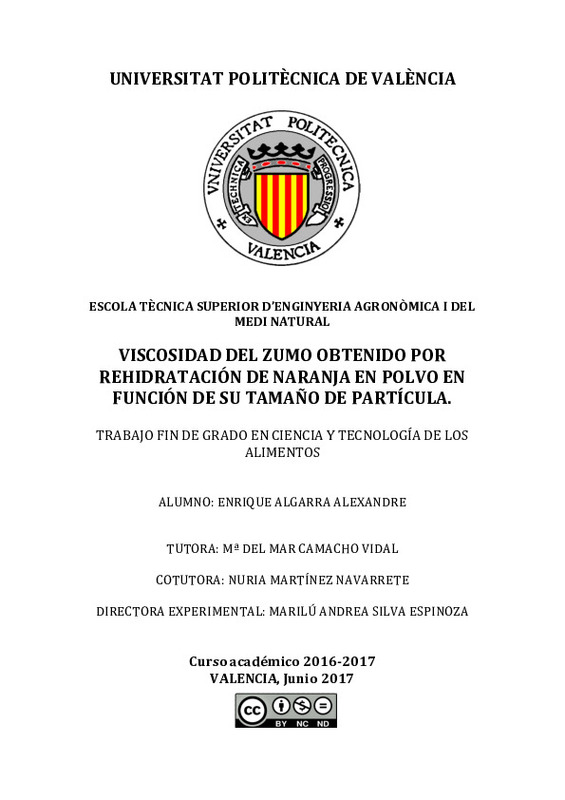|
Resumen:
|
[ES] Las frutas son componentes esenciales de una dieta saludable, pudiendo contribuir a la
prevención de enfermedades cardiovasculares y algunos cánceres. Esta protección es atribuida
a su contenido en ...[+]
[ES] Las frutas son componentes esenciales de una dieta saludable, pudiendo contribuir a la
prevención de enfermedades cardiovasculares y algunos cánceres. Esta protección es atribuida
a su contenido en compuestos bioactivos y fitoquímicos, que contribuyen a su capacidad
antioxidante. No obstante, las frutas frescas tienen una corta vida útil asociada a su alto
contenido en agua. La liofilización es un método de deshidratación con el que se consiguen
productos con alta calidad, y en los que además es aprovechada toda la parte comestible de la
fruta. A día de hoy, se pueden encontrar una gran variedad de zumos de frutas en el mercado,
pero ninguno de ellos obtenido mediante liofilización de puré de fruta. Después de liofilizar el
puré, se obtiene una torta, que debe ser triturada antes de rehidratarse. En este trabajo se
pretende obtener un polvo de puré liofilizado de naranja que, tras su rehidratación hasta su
contenido de agua inicial, tenga un comportamiento reológico similar al de los zumos
comerciales existentes. Con tal propósito, se decidió primero estudiar la influencia de la
adición de diferentes solutos de alto peso molecular en el comportamiento reológico del
rehidratado obtenido. En segundo lugar, se estudió la relación entre el tamaño de partícula del
polvo obtenido al triturar la torta de puré liofilizado y el comportamiento reológico del
producto tras la rehidratación del mismo. Para obtener los diferentes tamaños de partícula, la
muestra triturada se tamizó a través de aperturas de malla de 0,5, 0,4, 0,3, 0,2 y 0,15 mm. Se
caracterizó el comportamiento reológico de todos estos rehidratados y también el de cuatro
zumos de naranja comerciales con los que realizar comparaciones. Se comprobó la influencia
de los diferentes solutos y se escogió una formulación con goma arábiga (Ga) y fibra de bambú
(Fb) para realizar con ella la segunda parte del estudio. En dicha parte se concluyó que la
viscosidad del producto rehidratado disminuyó a medida que disminuyó el tamaño de
partícula del polvo, de modo que parece posible relacionar ésta con el tamaño de partícula del
polvo.
[-]
[EN] Fruits are essential components of a healthy diet and can contribute to the prevention of
cardiovascular diseases and some cancers. This protection is attributed to their content in
bioactive ...[+]
[EN] Fruits are essential components of a healthy diet and can contribute to the prevention of
cardiovascular diseases and some cancers. This protection is attributed to their content in
bioactive compounds and phytochemicals, which contribute to its antioxidant capacity.
However, fresh fruits have a short shelf life associated with their high water content. Freezedrying
is a dehydration method that provides high-quality products and that also makes the
most of the edible part of the fruit. Nowadays, a wide variety of fruit juices can be found on
the market, but none of them obtained by freeze-drying fruit puree. After freeze-drying the
puree, a cake is obtained, which must be crushed before being rehydrated. In this work, we
intend to obtain a powder of freeze-dried orange puree, which after being rehydrated until its
initial water content will have a similar rheological behavior than commercial orange juices.
For this purpose, it was decided to first study the influence of the addition of different high
molecular weight solutes on the rheological behavior of the rehydrated obtained. Secondly,
the relationship between the particle size of the sieved powder obtained by crushing the
freeze-dried cake, and the rheological behavior of the product after its rehydration was
studied. To obtain the different particle sizes, the crushed sample was sieved through
apertures of 0.5, 0.4, 0.3, 0.2 and 0.15 mm mesh. The rheological behavior of these rehydrated
samples and also of four commercial orange juices was characterized. The influence of the
different solutes was proved, and a formulation with arabic gum (Ga) and bamboo fiber (Fb)
was chosen to perform the second part of the study. In this part it was concluded that the
viscosity of the rehydrated product decreased as the particle size of the powder decreased, so
that it seems possible to relate it to the particle size of the powder.
[-]
|







